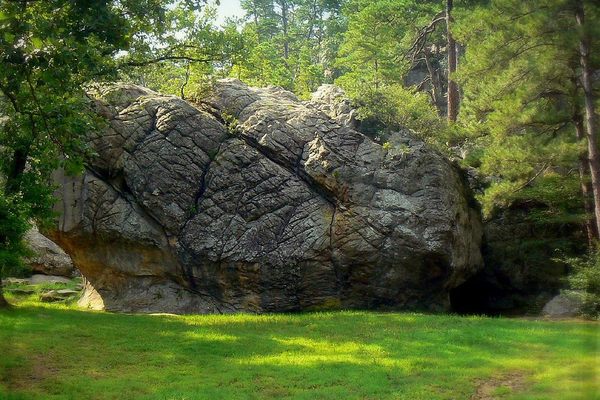Curious Fact of the Week: The World’s Most Inspirational Cave
Few places in the world can claim such an artistic legacy as Fingal’s Cave. The sea cave on the edge of the uninhabited Scottish island of Staffa had its strangely uniform hexagonal basalt columns formed thousands of years ago when lava slowly cooled and cracked. Ever since the cave was rediscovered in 1772 by naturalist Sir Joseph Banks, those six-sided forms have offered endless wonder to composers, artists, novelists, poets, and others who are captured by the curious sight.
Fingal’s Cave (photograph by Michelle O’Connell)
1774 engraving of Fingal’s Cave, illustrated by John Cleveley (via Wikimedia)
The name Fingal comes from an epic 18th century poem by James Macpherson, but the legend of the cave is much older than that. One story goes that it’s part of a bridge an Irish giant named Finn McCool built to go wage war on his Scottish giant rival Benandonner. It happened that the rediscovery of the cave coincided with Romanticism, a time when nature with its danger and splendor was central to art, which played no small part in its high profile as a tourist destination and inspirational source. And it still has an influence, appearing in everything from Pink Floyd’s early music to Matthew Barney’s Cremaster films.
Here are just a few examples of art inspired by Fingal’s Cave:
Composer Felix Mendelssohn was inspired by the cathedral-like acoustics of Fingal’s Cave, taking the sound as inspiration for “The Hebrides Overture,” which premiered in London in 1832.
J. M. W. Turner, “Staffa, Fingal’s Cave” (1832) (via Yale Center for British Art)
The same year Mendelssohn stunned his audiences with his Fingal’s Cave opus, prolific landscape artist J. M. W. Turner captured the turmoil of the cave in this oil painting.
Thomas Moran, “Fingal’s Cave, Island of Staffa, Scotland” (1884) (via High Museum of Art)
Not to be out done, equally iconic landscape artist Thomas Moran did his own take on the mysterious cave, swarming it with clouds, crashing waves, and seagulls that seem to originate from the darkness.
The frontispiece of “Le Rayon Vert” by Jules Verne (via Coll. Gilles Dawidowicz)
Jules Verne was one of the many authors fascinated with Fingal’s Cave, using it as a setting in his 1882 book Le Rayon Vert (The Green Ray), about two people attempting to see a strange green ray in Scotland (although they find love instead and miss it). William Wordsworth, Lord Tennyson, and John Keats also captured the cave in poetry. For example, here’s Keats: “Not Aladdin magian / Ever such a work began; / Not the wizard of the Dee / Ever such a dream could see; / Not Saint John, in Patmos’ isle, / In the passion of his toil, / When he saw the churches seven, / Golden aisled, built up in heaven, / Gazed at such a rugged wonder!”
Natural History Museum in London (photograph by Fr Lawrence Lew, O.P.)
Even architects have taken inspiration from the natural forms of the cave, such as the Natural History Museum in London whose tiered Romanesque grand entrance was inspired by Fingal’s Cave.
Inside Fingal’s Cave (photograph by Philip Bragg)
And if you also want to see what artistic inspiration might be waiting for you in the sea cave, there are still boat trips that take visitors to its geologically stunning shores.
FINGAL’S CAVE, Staffa, Scotland
Curious Facts of the Week: Helping you build your cocktail party conversation repertoire with a new strange fact every week, and an amazing place to explore its story. See all the Curious Facts here>














Follow us on Twitter to get the latest on the world's hidden wonders.
Like us on Facebook to get the latest on the world's hidden wonders.
Follow us on Twitter Like us on Facebook